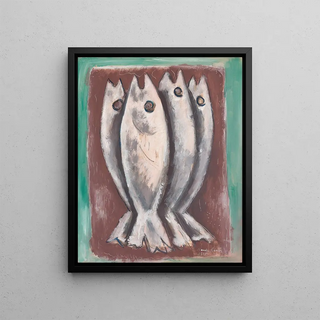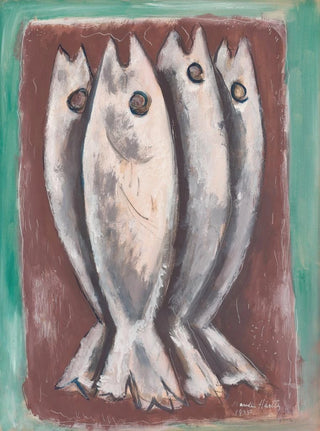Art print | Ghosts of the Sea - Marsden Hartley


View from behind

Frame (optional)
Captivating Introduction
In the enchanting world of modern art, the art print "Ghosts of the Sea" by Marsden Hartley stands as a true ode to nature and the spirit. This piece, imbued with mystery and poetry, evokes the maritime depths while playing on human perceptions. Hartley, through his vibrant colors and abstract forms, manages to capture the very essence of the ocean, a world where the invisible and the visible meet. The art print of this work allows viewers to immerse themselves in an atmosphere that is both serene and unsettling, revealing the secrets held by the sea. It invites meditative contemplation, a journey into the human soul in the face of the vastness of the waves.
Style and uniqueness of the work
"Ghosts of the Sea" is distinguished by its bold use of color and form, characteristic of Hartley's unique style. The artist plays with deep, nuanced shades that evoke the reflections of water, while incorporating geometric elements that suggest marine silhouettes. This hybrid approach, blending abstraction and figuration, creates a captivating visual dynamic. The forms, although stylized, seem to vibrate with their own life, as if animated by ocean currents. Hartley succeeds in transcending simple representation to offer a sensory experience, where the viewer is invited to feel rather than analyze. This work is thus a testament to the capacity of art to evoke deep emotions and reflections on our relationship with nature.
The artist and his influence
Marsden Hartley, an emblematic figure of American modernism, knew how to mark his era with his innovative contributions to art. Born in 1877, he was influenced by European avant-garde movements while developing a style that is uniquely his own, rooted in the American landscape. His fascination with nature, particularly the maritime landscapes of New England, is reflected in his works. Hartley was also a pioneer in exploring themes of identity and spirituality, incorporating autobiographical elements into his art. His influence endures today,

Matte finish

View from behind

Frame (optional)
Captivating Introduction
In the enchanting world of modern art, the art print "Ghosts of the Sea" by Marsden Hartley stands as a true ode to nature and the spirit. This piece, imbued with mystery and poetry, evokes the maritime depths while playing on human perceptions. Hartley, through his vibrant colors and abstract forms, manages to capture the very essence of the ocean, a world where the invisible and the visible meet. The art print of this work allows viewers to immerse themselves in an atmosphere that is both serene and unsettling, revealing the secrets held by the sea. It invites meditative contemplation, a journey into the human soul in the face of the vastness of the waves.
Style and uniqueness of the work
"Ghosts of the Sea" is distinguished by its bold use of color and form, characteristic of Hartley's unique style. The artist plays with deep, nuanced shades that evoke the reflections of water, while incorporating geometric elements that suggest marine silhouettes. This hybrid approach, blending abstraction and figuration, creates a captivating visual dynamic. The forms, although stylized, seem to vibrate with their own life, as if animated by ocean currents. Hartley succeeds in transcending simple representation to offer a sensory experience, where the viewer is invited to feel rather than analyze. This work is thus a testament to the capacity of art to evoke deep emotions and reflections on our relationship with nature.
The artist and his influence
Marsden Hartley, an emblematic figure of American modernism, knew how to mark his era with his innovative contributions to art. Born in 1877, he was influenced by European avant-garde movements while developing a style that is uniquely his own, rooted in the American landscape. His fascination with nature, particularly the maritime landscapes of New England, is reflected in his works. Hartley was also a pioneer in exploring themes of identity and spirituality, incorporating autobiographical elements into his art. His influence endures today,






